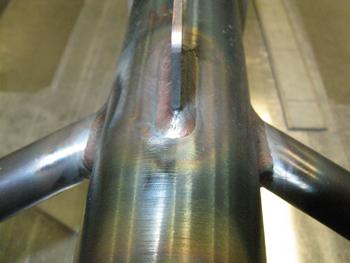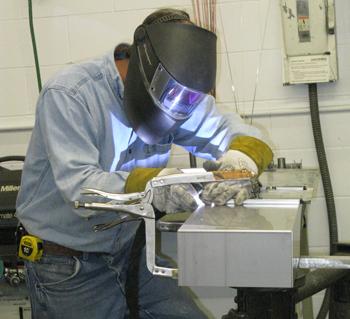Senior Editor
- FMA
- The Fabricator
- FABTECH
- Canadian Metalworking
Categories
- Additive Manufacturing
- Aluminum Welding
- Arc Welding
- Assembly and Joining
- Automation and Robotics
- Bending and Forming
- Consumables
- Cutting and Weld Prep
- Electric Vehicles
- En Español
- Finishing
- Hydroforming
- Laser Cutting
- Laser Welding
- Machining
- Manufacturing Software
- Materials Handling
- Metals/Materials
- Oxyfuel Cutting
- Plasma Cutting
- Power Tools
- Punching and Other Holemaking
- Roll Forming
- Safety
- Sawing
- Shearing
- Shop Management
- Testing and Measuring
- Tube and Pipe Fabrication
- Tube and Pipe Production
- Waterjet Cutting
Industry Directory
Webcasts
Podcasts
FAB 40
Advertise
Subscribe
Account Login
Search
No-nonsense lean at Micron Metalworks
Minnesota job shop takes a pragmatic approach to continuous improvement
- By Tim Heston
- October 9, 2013
- Article
- Shop Management

Figure 1: Micron’s shop floor didn’t always look like this. Until several years ago, much of the floor was taken up by old equipment and work-in-process (WIP).
Ed Kittelson’s life adventure started four decades ago in a 1971 Vega hatchback packed with everything he owned. He grew up in Anoka, Minn., northwest of the Twin Cities; moved south during his junior high and high school years; and upon graduation was ready for a change. He had no other real plans, no money; all he knew is he wanted to start another life back home.
So off he went, his Vega roaring north from the overbearing heat of Brownsville—at the southernmost tip of Texas—back to Anoka. Four days later he landed a job at a local stamper and metal fabricator, pulling in $135 a week.
“I was all alone, really,” he said. “I had family [in Anoka], but they all were married and had families. So long story short, I just worked really hard.”
Picture a no-nonsense Yankees general manager (OK, maybe the Twins). Put a Hawaiian shirt on him. Now add a healthy dose of friendly, grateful Minnesota humility. That’s Kittelson. Now president of Micron Metalworks—a $10 million, 60,000-square-foot fabricator in Ham Lake, not far from Anoka—Kittelson has a casual air about him, one that’s easy to pick up on when you listen to his voicemail message. He doesn’t say he can’t pick up because he’s too busy to talk; he’s just on the golf course (see Figures 1 and 2).
For years Kittelson had heard all the hype on lean manufacturing, but how could it possibly be practical for a job shop like his, where every job is different? How can you draw an effective value stream map for a shop floor with hundreds of different part routings? And what about takt time, the drumbeat of manufacturing set by customer demand? As a job shop, Micron has highly variable demand; things can be busy one week, slow the next. Moreover, the shop produces thousands of different parts, each with its own ideal cycle times. Setting a consistent drumbeat to it all isn’t very practical.
Then in 2004 one of Micron’s major customers brought Kittelson’s management team in to see the OEM’s progress in lean manufacturing for its assembly operation. “They had what they called the 13-second rule,” Kittelson recalled. “They said, ‘Watch anybody for 13 seconds. Anybody that’s standing still, mark that down.’”
Using this data, the company devised an internal formula to estimate overall efficiency. The idea, designed for the assembly line, didn’t really apply to Micron’s job shop work flow, but the approach seemed pragmatic. It avoided kanban, muda, takt time, and all the other buzzwords. Instead, it involved simple observation of what was happening on the shop floor. At Micron, an operator standing idle, monitoring the laser or turret, isn’t a problem. But say an operator is scurrying about the place, frantically trying to find tools and raw stock to get a job started. That’s a problem.
So began Micron’s lean journey. It’s not one that involved manufacturing cells or an utter change to the shop layout. Like Kittelson himself, the transformation was and remains practical.
Beginnings
Kittelson caught the manufacturing bug early. At one point he lived and breathed the business nearly 24 hours a day. A few years after his Vega brought him back to Anoka, he became third-shift supervisor at a local fabricator, and at the same time pulled day shifts in sales and estimating for the same manufacturer. At 27 he landed a job as general manager at another major fabricator, a position he quickly found to be too much too soon. “It wasn’t a good fit for me,” he said. “I was in way over my head.”
So he left to become a national sales engineer for another manufacturer. After traveling the country for about six years as an independent sales rep, he returned to Anoka and got a job at a local contract fabricator that happened to be struggling. “It was poorly managed, owned by a large conglomerate,” he recalled. “All they were doing was milking the place. And I thought, ‘If this place can run, I can make it.’”

Figure 2: Last year Micron Metalworks hosted a shop tour during LeanFab, a workshop dedicated to lean manufacturing in metal fabrication, organized by the Fabricators & Manufacturers Association Intl. Ed Kittelson, company president, is wearing his signature Hawaiian shirt. Steve Jaeger, a shop spider who stages material and tools for machine operators, is on the left.
In 1993 Kittelson got word of a local two-man job shop for sale. The fabricator wasn’t anything special. The 4,000-sq.-ft. floor had a shear, a turret punch press, a press brake, and a machining center, all of which generated about $300,000 in annual sales. He needed $50,000 down to buy the business. No one he knew was willing to pony up the cash, and with his short credit history, banks weren’t about to loan him that kind of money. So he cobbled together the funds using, of all things, cash advances on credit cards.
“I literally had a grocery bag of cash,” he said. “That was my down payment. And on Feb. 18, 1994, we took the keys.”
So began Micron Metalworks. With this kind of prelude, you’d think this story would have a tragic end, with the freewheeling entrepreneur piling up a mountain of debt and underquoting into oblivion. But despite its unconventional start, Micron has evolved into a profitable, streamlined, and, most important to Kittelson, pragmatic manufacturing operation.
Making Micron Unique
At previous companies Kittelson noticed all sorts of things that just didn’t make sense. For instance, why weren’t machine operators responsible for quality? Managers judged operators by how many parts they could produce during a given period, and the more the better. Quality personnel were judged by how well they caught defects. So from the operators’ perspective, bad parts were the quality department’s problem, not theirs.
“But the quality personnel didn’t make the parts,” Kittelson recalled. “That never made sense to me. So that’s the foundation of where [Micron] started. Everybody is responsible for the quality of their own product.” Quality control remains critical—and Micron maintains a robust QC department, of course—but operators also are responsible for the quality of parts they make.
Micron isn’t the cheapest shop around. Some customers have left for a better deal, only to return several months later because Micron’s competitors couldn’t deliver. The shop tackles work others can’t, and much of this involves jobs requiring precise gas tungsten arc welding. For instance, the shop produces landing gears for Cirrus Aircraft. These products require a technician to expertly wield a torch around tight corners. A landing gear is an extraordinarily critical component, of course, so the full-penetration fillet welds undergo extensive nondestructive examination, including X-ray and magnetic particle tests (see Figure 3).
Moreover, Micron must send these products to a heat-treating facility near Philadelphia, one of only two companies in the country (the other being in California) with the right heat-treating oven (a World War II vintage system) and quenching processes for these products. The fabricator may need to send the parts halfway across the country for heat treating, but you can’t find Micron’s welding talent everywhere (see Figure 4).
Micron also produces a chute for a food processing machinery manufacturer. The chute shuttles bags for cereal boxes, and because it works in such a high-speed operation, the chute’s tolerances are extraordinarily tight.
“We knew the costs and gave a price,” Kittelson said. “This is a fairly high-volume product for us. There are 50 chutes per machine, and the company was building 200 machines. After seeing our price, the company went to another fabricator that quoted lower. They worked with that fabricator for a month and a half and never got a good product. They even switched the design to a machined product, which was far more expensive, and even that didn’t work.
“Then they came back to us. We designed some very specific collapsing [weld] fixturing for this, to keep out the heat and reduce warpage. But most of all, it’s the quality of our welders. These guys are phenomenal.”
Why 5S Really Matters
Micron offers quick delivery, but so do other area fabricators. Quality historically is why customers buy from Micron, particularly in bending and welding. It was from this competitive position that Kittelson’s team began looking into continuous improvement.
Through the years the team purchased new brakes, machining centers, welding equipment, and tube bending systems. As the company added equipment, the shop floor soon became littered with old machines that perhaps could be used but in reality never were. In short, the place was becoming a mess.
So began Micron’s 5S effort. In Chicago they attended a seminar hosted by Dick Kallage, principal of Barrington, Ill.-based KDC & Associates (and columnist for this magazine). Kallage talked of what he called “practical lean,” a brand of lean manufacturing tailored for the high-mix, low-volume job shop.
During the seminar Kallage described the two-minute challenge. The goal is that workstations, materials, and procedures should be organized, labeled, and explained so clearly that someone who has never set foot on the shop floor can find the tools and raw material necessary for a job—all within two minutes.
This is the ultimate achievement for 5S (sort, straighten, shine, standardize, sustain). A sorted, neat, labeled workstation may look organized and professional, but it serves little purpose if only a few people in the shop can look at it and know where to find all the tools they need. With shadow boards, cabinets, and visual cues throughout the shop, 5S ensures parts flow continually from one operation to the next, and ensures that flow isn’t hindered by misunderstandings or miscommunication.
Tools need to be labeled clearly, common setups illustrated. Work instructions on the job traveler should be visual and complete to minimize misinterpretation, no matter who may be at the work center or department during a given shift. A few people calling in sick shouldn’t throw a major wrench into production (see Figure 5).
Kittelson brought the practice back to Micron. He implemented what he called “red tag” events. “We started putting red tags on stuff that was just lying around,” he said. “It was basically just junk that we couldn’t sell, like old templates for jobs that had come and gone. They had no reason to be there. Some areas were just a mess. In one area we cleaned up 600 square feet of stuff. At the end, the floor was totally bare. And we started getting rid of machines—like old drill presses and equipment that wasn’t being used.”
Where Did the Cash Go?
The shop floor looked tidier and, at least on the surface, everything seemed to operate like a finely tuned system. In 2008 came an especially busy period. The shop floor was hopping with activity, and everything looked rosy.
Then one day, Kittelson’s wife Linda, who has handled the books since Micron’s launch, walked into her husband’s office. “She is the behind-the-scenes person that has juggled cash flow and kept me on the straight and narrow,” Kittelson said. “She’s the real hero.” And that day, she showed him an unexpected reality: Payables were rising and receivables were falling, yet the shop was busier than ever. What was going on?
At that point Kallage was invited to the shop. He toured the warehouse, called the “back barn,” full of sheet stock, and then the deburring area, which was piled high with work-in-process (WIP). He turned to Kittelson and asked why the shop had all this material. All that material costs money, of course, and it was causing those payables to rise more dramatically than revenue—not a good thing.
“In my world up to that point, the lasers and turrets had to run, 24/7,” Kittelson said. After all, the turret and laser were new machines, and the turret had automation that allowed it to run lights-out over an entire weekend. For years he had learned to run primary cutting and punching systems flat out for maximum efficiency. If a machine isn’t running, it isn’t making money. But that day Kittelson suddenly realized the fallacy of that statement.
Machines running actually spend money—on electricity, labor, tooling, material, and other consumables. And if they just make a downstream bottleneck worse, all this seemingly productive machine uptime in the cutting department is really just waste.
“So I went to our plant manager and I said, ‘We’re going to shut down the lasers and turrets until all that [WIP] in deburring is cleaned up. Because it doesn’t make any sense to burn electricity and use up more material if we can’t get that material through deburring.”
With the cutting department idle, those employees moved down to deburring, and within half a day they relieved the bottleneck. That bottleneck moved next to the press brake area, hardware insertion, finishing, and assembly, but within a few days the shop floor was cleaned up, and parts finally started flowing again.
From here other improvements ensued, and much of it hinged on pragmatic observation as well as effective use of overall equipment effectiveness (OEE) measurements. OEE considers three key percentages—machine availability; the quality rate (good parts versus total parts); and the performance rate (actual versus ideal cycle times).
Micron especially focused on machine availability. The saying “If it’s not running, it’s not making money” has pervaded manufacturing for a reason. If a machine isn’t running, it’s usually being set up for the next job, and those setups can last a long time for various reasons. An operator may not be able to find material or the tools needed for the next job.
That’s why Micron’s operators ran extra parts. After all, this job would surely be ordered again in a week or two. Why not produce extra now and save on setup? Of course, this floods the shop with work that’s not needed immediately and ties up the machine. So in reality, the machine becomes unavailable to meet immediate customer demand.
“If the customer has ordered split deliveries, we build only what we can ship,” Kittelson said.
Improvement Ramps Up
Micron underwent a cultural change. The shop began producing only what was needed, and instead of trying to reduce the number of setups, employees began scrutinizing setup procedures to make each changeover faster. As Kallage explained, “You’re not in the manufacturing business. You’re in the changeover business.”
The company eliminated its stacks of raw stock in the material barn and worked with its service centers to deliver stock just in time. Today the company has only a small raw stock storage area. And that storage area itself has changed dramatically. Early on in Micron’s improvement efforts, managers observed operators in punching and laser cutting to find out what exactly was prolonging changeover. Turns out, they spent relatively little time actually setting up the machine. They instead spent most of their time searching for tools and, especially, material. Material just wasn’t labeled or organized.
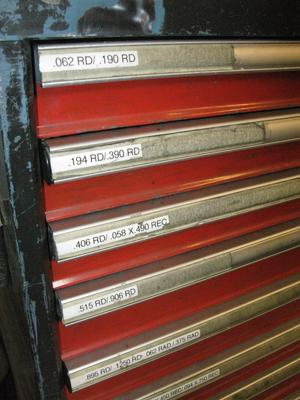
Figure 5: At the turret press, Micron keeps its tooling labeled and organized so that anyone in the shop can find a tool when needed.
So one day Kittelson brought in simple cards of different colors. Each card had space on it to identify the material grade, and the color corresponded to material type—green for aluminum, blue for carbon steel, and so on (see Figure 6). He showed these cards to his purchasing manager, who looked at them, paused, and shook his head.
“You’ve got to be kidding me,” the purchasing manager said.
Kittelson was a bit surprised. “What’s the matter?”
“I’m completely color-blind.”
The two laughed. “Well, you can read what’s on them,” Kittelson said.
Turret tools were placed in cabinets and labeled. Press brake tools were labeled and organized on wheeled racks (see Figure 7), placed next to the brakes that use those tools the most. To reduce brake changeover times further, the shop invested in offline bend simulation and programming, all performed by a technician at a workstation near the brake department.
Of course, organizing workspaces, raw material, and tooling can reduce changeover time only so much. Moreover, if an operator continually focuses on material flow and reducing setup time, he could spend more time staging and organizing material and tooling, and less time actually focusing on the fabrication process at hand.
To help this situation, Micron employs spiders. Borrowed from the lean term water spider or water strider, Micron’s spiders are more than just material handlers. They prestage material and tooling for all jobs on the floor and, in essence, keep one eye on the big picture. One spider, Steve Jaeger, explained how he prestages upcoming jobs and, when necessary, operates a press brake, laser or turret, or helps out in the assembly area.
“Whether it’s shearing material and having it staged at the machine, or sharpening tools or finding tools, we make sure the next job is ready when the operator arrives,” Jaeger said. “I also check in the material, unload it off the trucks, and organize it in the shear area. If they need material sheared, I can make that happen.
“If they need material moved around, I can also make that happen. It all depends on the work for the day. But regardless, when I arrive in the morning, I look at the schedule and determine what needs to happen to get the machines running.”
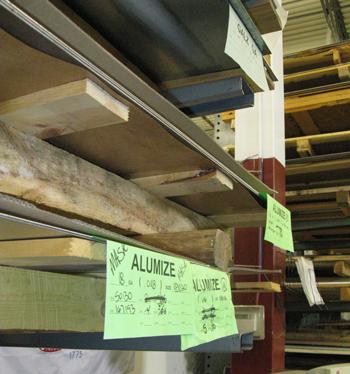
Figure 6: In Micron’s raw stock area, color-coded cards identify the material, type, grade, and certifications.
Less Walking, Better Communication
In Micron’s machining department—which mainly produces milled and turned components for sheet metal assemblies—cutting tools for the milling centers were organized in a toolroom near the machining department. And the machining centers themselves were rearranged so that multiple work envelopes face one operator. This allows one operator to run up to three machines at once—one in front of him, and two on either side.
Another improvement entailed a portable hardware insertion machine. Because of access restrictions, some parts need to have hardware inserted in the middle of the bending sequence. So for years operators bent a batch halfway through, walked to the other side of the shop to insert the hardware, then walked back to the brake.
That’s a lot of walking over a shift, and a hardware insertion machine on wheels helped overcome this problem. When needed, the hardware insertion press is wheeled adjacent to the press brake. The technician now can make the first few bends on the brake, turn to the hardware press to insert the necessary fasteners, and then turn back to the brake to complete the bending sequence (see Figure 8).
Hardware insertion itself is a challenge for many job shops. It’s tedious, detail-oriented work. “I’ve always struggled with this at other companies,” Kittelson said. “You always find some guy off the street who’s never been in a shop, and you make him the hardware guy. And we wonder why a part is missing four fasteners, or has one that’s the wrong type.”
The later an error occurs in a job, the more expensive that error is, and especially when a problem isn’t caught before it leaves the door. “There’s nothing more a customer hates than a hardware problem,” Kittelson said. “So rather than having inexperienced people in the hardware department, we started assigning some of our best talent to the area, people who are always thinking how we can eliminate problems.”
For instance, if a job required 350 of a certain kind of fastener, the workers filled a bag with 350. If the bag had any left over after processing the batch, they knew something went awry. “They started eliminating the hardware problems,” Kittelson said. “I don’t remember the last time we had a rejected part [from hardware errors]. It has made such a difference.”
The shop has made other strategic equipment upgrades. Its new spot welding system has a flat copper platform that acts as the bottom electrode, making it much easier for a technician to insert spot welds in parts of various shapes (see Figure 9). To improve working conditions, the company installed sound abatement panels above the turret punch presses. It also built a demo display to define part finishes, ensuring the customer and sales engineer are on the same page (see Figure 10). Micron also has scissor-lift tables that can lift workpieces to a comfortable height (see Figure 11). And it bought an automated shrink-wrapping system so workers need not break their backs wrapping orders to be shipped.
The company rearranged front-office operations too. Previously engineering and quality control had been in walled offices in the middle of the shop floor. Initially this made sense: They were close to the people and machines making the product. But over time managers realized how this physical separation from the front office caused communication problems. Orders and part revisions can change continually, and a communication breakdown in the front office can snowball into a lot of wasted production time. To remedy the situation, the company decided to tear down the walls on the shop floor, open up the space, and move QC and engineering near the front office.
As Kittelson explained, “QC and engineering, purchasing, production control, upper management, they’re all together again. The communication improved greatly, and quality improved. Yes, it was an investment, but it was a good investment.”
Fostering Talent
There’s a noticeable trend here. Most changes and equipment upgrades focus on worker communication, safety, and ergonomics. The less back-breaking labor a job requires, the better and more efficient the working conditions are. It also makes for happier employees.
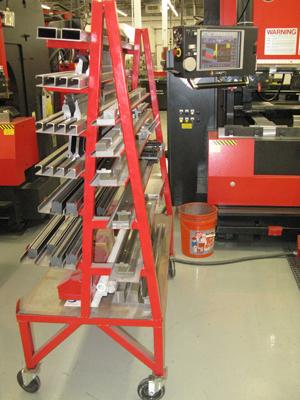
Figure 7: Micron organized and labeled its press brake tooling and placed the most used tools on wheeled racks.
All this has helped shorten the order to cash cycle, or the time between sending cash out for material, labor, and machine operation and getting paid for a completed order. That’s the financial side. But there’s also a human side. Jobs like welding, machining, and press brake operation have always employed skilled, often experienced individuals. But metal fabrication has evolved to the point where many jobs that once were low- or semiskilled positions now require a different kind of person, one with more skill, curiosity, enthusiasm, and engagement.
A material handler like Jaeger doesn’t just move parts from point A to point B. As a spider, he pre-stages tooling and material. He can set up workstations and operate various machine tools. He effectively manages work flow for the entire shop. Also consider Micron’s highly engaged personnel in the hardware department. To customers, a beautifully formed or welded part doesn’t really matter if it can’t fit onto the final assembly, all because of one wrong fastener.
As Kittelson explained, the entire process really helped managers leverage the talent of shop floor employees. Without that talent, of course, none of the improvements could have taken place. “I know I’m not very smart,” he said, “so I know it has to be the people.”
About the Author

Tim Heston
2135 Point Blvd
Elgin, IL 60123
815-381-1314
Tim Heston, The Fabricator's senior editor, has covered the metal fabrication industry since 1998, starting his career at the American Welding Society's Welding Journal. Since then he has covered the full range of metal fabrication processes, from stamping, bending, and cutting to grinding and polishing. He joined The Fabricator's staff in October 2007.
Related Companies
subscribe now

The Fabricator is North America's leading magazine for the metal forming and fabricating industry. The magazine delivers the news, technical articles, and case histories that enable fabricators to do their jobs more efficiently. The Fabricator has served the industry since 1970.
start your free subscription- Stay connected from anywhere

Easily access valuable industry resources now with full access to the digital edition of The Fabricator.

Easily access valuable industry resources now with full access to the digital edition of The Welder.

Easily access valuable industry resources now with full access to the digital edition of The Tube and Pipe Journal.
- Podcasting
- Podcast:
- The Fabricator Podcast
- Published:
- 04/16/2024
- Running Time:
- 63:29
In this episode of The Fabricator Podcast, Caleb Chamberlain, co-founder and CEO of OSH Cut, discusses his company’s...
- Industry Events
16th Annual Safety Conference
- April 30 - May 1, 2024
- Elgin,
Pipe and Tube Conference
- May 21 - 22, 2024
- Omaha, NE
World-Class Roll Forming Workshop
- June 5 - 6, 2024
- Louisville, KY
Advanced Laser Application Workshop
- June 25 - 27, 2024
- Novi, MI
























